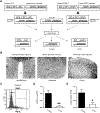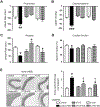Activation of ADAM17 (A Disintegrin and Metalloprotease 17) on Glutamatergic Neurons Selectively Promotes Sympathoexcitation
- PMID: 31006330
- PMCID: PMC6506373
- DOI: 10.1161/HYPERTENSIONAHA.119.12832
Activation of ADAM17 (A Disintegrin and Metalloprotease 17) on Glutamatergic Neurons Selectively Promotes Sympathoexcitation
Abstract
Chronic activation of the brain renin-angiotensin system contributes to the development of hypertension by altering autonomic balance. Beyond the essential role of Ang II (angiotensin II) type 1 receptors, ADAM17 (A disintegrin and metalloprotease 17) is also found to promote brain renin-angiotensin system overactivation. ADAM17 is robustly expressed in various cell types within the central nervous system. The aim of this study was to determine whether ADAM17 modulates presympathetic neuronal activity to promote autonomic dysregulation in salt-sensitive hypertension. To test our hypothesis, ADAM17 was selectively knocked down in glutamatergic neurons using Cre-loxP technology. In mice lacking ADAM17 in glutamatergic neurons, the blood pressure increase induced by deoxycorticosterone acetate-salt treatment was blunted. Deoxycorticosterone acetate-salt significantly elevated cardiac and vascular sympathetic drive in control mice, while such effects were reduced in mice with ADAM17 knockdown. This blunted sympathoexcitation was extended to the spleen, with a lesser activation of the peripheral immune system, translating into a sequestration of circulating T cells within this organ, compared with controls. Within the paraventricular nucleus, Ang II-induced activation of kidney-related presympathetic glutamatergic neurons was reduced in ADAM17 knockdown mice, with the majority of cells no longer responding to Ang II stimulation, confirming the supportive role of ADAM17 in increasing presympathetic neuronal activity. Overall, our data highlight the pivotal role of neuronal ADAM17 in regulating sympathetic activity and demonstrate that activation of ADAM17 in glutamatergic neurons leads to a selective increase of sympathetic output, but not vagal tone, to specific organs, ultimately contributing to dysautonomia and salt-sensitive hypertension.
Keywords: central nervous system; immune system; mice; neurons; renin-angiotensin system.
Conflict of interest statement
Conflict of interest/Disclosure:
None.
Figures






Similar articles
-
ACE2 and ADAM17 Interaction Regulates the Activity of Presympathetic Neurons.Hypertension. 2019 Nov;74(5):1181-1191. doi: 10.1161/HYPERTENSIONAHA.119.13133. Epub 2019 Sep 30. Hypertension. 2019. PMID: 31564162 Free PMC article.
-
Brain angiotensin-converting enzyme type 2 shedding contributes to the development of neurogenic hypertension.Circ Res. 2013 Oct 12;113(9):1087-1096. doi: 10.1161/CIRCRESAHA.113.301811. Epub 2013 Sep 6. Circ Res. 2013. PMID: 24014829 Free PMC article.
-
Clinical Relevance and Role of Neuronal AT1 Receptors in ADAM17-Mediated ACE2 Shedding in Neurogenic Hypertension.Circ Res. 2017 Jun 23;121(1):43-55. doi: 10.1161/CIRCRESAHA.116.310509. Epub 2017 May 16. Circ Res. 2017. PMID: 28512108 Free PMC article.
-
Role of ADAM17 in kidney disease.Am J Physiol Renal Physiol. 2019 Aug 1;317(2):F333-F342. doi: 10.1152/ajprenal.00625.2018. Epub 2019 May 29. Am J Physiol Renal Physiol. 2019. PMID: 31141400 Review.
-
Glutamatergic Regulation of Hypothalamic Presympathetic Neurons in Hypertension.Curr Hypertens Rep. 2017 Sep 19;19(10):78. doi: 10.1007/s11906-017-0776-4. Curr Hypertens Rep. 2017. PMID: 28929331 Review.
Cited by
-
ADAM17-Mediated Shedding of Inflammatory Cytokines in Hypertension.Front Pharmacol. 2020 Jul 29;11:1154. doi: 10.3389/fphar.2020.01154. eCollection 2020. Front Pharmacol. 2020. PMID: 32848763 Free PMC article. Review.
-
Angiotensin-Converting Enzyme-2 (ACE2) Downregulation During Coronavirus Infection.Mol Biotechnol. 2024 Sep 13. doi: 10.1007/s12033-024-01277-5. Online ahead of print. Mol Biotechnol. 2024. PMID: 39266903 Review.
-
Use of chlorisondamine to assess the neurogenic contribution to blood pressure in mice: An evaluation of method.Physiol Rep. 2021 Feb;9(3):e14753. doi: 10.14814/phy2.14753. Physiol Rep. 2021. PMID: 33587331 Free PMC article.
-
Implications of ADAM17 activation for hyperglycaemia, obesity and type 2 diabetes.Biosci Rep. 2021 May 28;41(5):BSR20210029. doi: 10.1042/BSR20210029. Biosci Rep. 2021. PMID: 33904577 Free PMC article. Review.
-
AT1 Receptors: Their Actions from Hypertension to Cognitive Impairment.Cardiovasc Toxicol. 2022 Apr;22(4):311-325. doi: 10.1007/s12012-022-09730-0. Epub 2022 Feb 24. Cardiovasc Toxicol. 2022. PMID: 35211833 Free PMC article. Review.
References
-
- Yamazato M, Yamazato Y, Sun C, Diez-Freire C, Raizada MK. Overexpression of angiotensin-converting enzyme 2 in the rostral ventrolateral medulla causes long-term decrease in blood pressure in the spontaneously hypertensive rats. Hypertension. 2007;49:926–931. - PubMed
Publication types
MeSH terms
Substances
Grants and funding
LinkOut - more resources
Full Text Sources
Medical
Molecular Biology Databases
Miscellaneous

